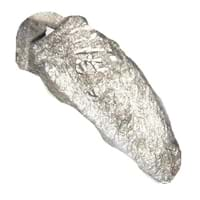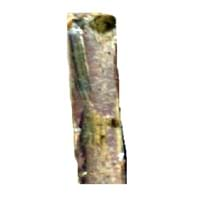Europium vs Radium
Periodic Table
Symbol
Eu
Ra
Group Number
Not Available
2
16
Period Number
6
7
Block
f block
s block
Element Family
Lanthanide
Alkaline Earth
CAS Number
7440531
34
7440144
99+
Space Group Name
Im_ 3m
Im_ 3m
Space Group Number
229.00
1
229.00
1
Facts
Interesting Facts
Not Available
- Radium metal is the heaviest metal of Alkaline earth metals column.
- Radium metal is highly radioactive and does not have any stable isotopes.
Sources
Found in Minerals, Mining, Ores of Minerals
Mining, Ores of metals
History
Who Discovered
Eugène-Anatole Demarçay
Not Available
Discovery
In 1896
In 1898
Abundance
Abundance In Universe
5 * 10-8 %
27
Not Available
Abundance In Sun
~0.00000005 %
27
~-9999 %
Abundance In Meteorites
0.00 %
99+
Not Available
Abundance In Earth's Crust
0.00 %
36
0.00 %
99+
Abundance In Oceans
0.00 %
99+
0.00 %
99+
Abundance In Humans
Not Available
0.00 %
20
Uses
Uses & Benefits
- Europium metals main uses is in the printing of euro banknotes. These notes glow red under UV light.
- It is used in low energy light bulbs.
- It is a highly radioactive metal; and sometime Radium-223 is used to treat prostate cancer.
- It is used in luminous paints.
Industrial Uses
Chemical Industry
NA
Medical Uses
NA
Pharmaceutical Industry
Other Uses
Alloys
NA
Biological Properties
Toxicity
Non Toxic
Highly Toxic
Present in Human Body
Yes
No
Physical Properties
Melting Point
822.00 °C
99+
700.00 °C
99+
Boiling Point
1,597.00 °C
99+
1,737.00 °C
99+
Appearance
Physical State
Solid
Solid
Color
Silvery White
Silvery White
Luster
Lustrous
Metallic
Hardness
Vickers Hardness
167.00 MPa
34
Not Available
Speed of Sound
Not Available
Not Available
Optical Properties
Allotropes
No
No
α Allotropes
Not Available
Not Available
β Allotropes
Not Available
Not Available
γ Allotropes
Not Available
Not Available
Chemical Properties
Chemical Formula
Eu
Ra
Isotopes
Known Isotopes
31
8
33
6
Electronegativity
Pauling Electronegativity
1.20
39
0.90
99+
Sanderson Electronegativity
1.01
22
Not Available
Allred Rochow Electronegativity
Not Available
0.97
38
Mulliken-Jaffe Electronegativity
Not Available
0.92
20
Allen Electronegativity
Not Available
0.89
99+
Electropositivity
Pauling Electropositivity
Not Available
3.10
5
Ionization Energies
1st Energy Level
547.10 kJ/mol
99+
509.30 kJ/mol
99+
2nd Energy Level
1,085.00 kJ/mol
99+
979.00 kJ/mol
99+
3rd Energy Level
2,404.00 kJ/mol
99+
Not Available
4th Energy Level
4,120.00 kJ/mol
33
Not Available
Electrochemical Equivalent
1.89 g/amp-hr
33
4.22 g/amp-hr
6
Electron Work Function
2.50 eV
99+
Not Available
Other Chemical Properties
Ionization, Radioactive Isotopes, Solubility
Ionization, Radioactive Isotopes, Radioactivity
Atomic Properties
Atomic Number
63
99+
88
30
Electron Configuration
[Xe] 4f7 6s2
[Rn] 7s2
Crystal Structure
Body Centered Cubic (BCC)
Body Centered Cubic (BCC)
Crystal Lattice
BCC-Crystal-Structure-.jpg#100
BCC-Crystal-Structure-.jpg#100
Atom
Number of Protons
63
99+
88
30
Number of Neutrons
89
38
138
16
Number of Electrons
63
99+
88
30
Radius of an Atom
Atomic Radius
180.00 pm
14
Not Available
Covalent Radius
198.00 pm
13
221.00 pm
3
Van der Waals Radius
233.00 pm
18
283.00 pm
4
Atomic Weight
151.96 amu
99+
226.00 amu
26
Atomic Volume
28.90 cm3/mol
8
45.20 cm3/mol
4
Adjacent Atomic Numbers
Valence Electron Potential
45.60 (-eV)
35
20.10 (-eV)
99+
Lattice Constant
458.10 pm
17
514.80 pm
13
Lattice Angles
π/2, π/2, π/2
π/2, π/2, π/2
Lattice C/A Ratio
Not Available
Not Available
Mechanical Properties
Density
Density At Room Temperature
5.26 g/cm3
99+
5.50 g/cm3
99+
Density When Liquid (at m.p.)
5.13 g/cm3
99+
Not Available
Tensile Strength
120.00 MPa
15
Not Available
Viscosity
Not Available
Not Available
Vapor Pressure
Vapor Pressure at 1000 K
19.40 (Pa)
4
Not Available
Elasticity properties
Shear Modulus
7.90 GPa
99+
Not Available
Bulk Modulus
8.30 GPa
99+
Not Available
Young's Modulus
18.20 GPa
99+
Not Available
Poisson Ratio
0.15
34
Not Available
Other Mechanical Properties
Ductile
NA
Magnetic Properties
Magnetic Characteristics
Specific Gravity
5.24
99+
5.00
99+
Magnetic Ordering
Paramagnetic
Nonmagnetic
Electrical Properties
Electrical Property
Conductor
NA
Resistivity
0.90 nΩ·m
99+
100.00 nΩ·m
31
Electrical Conductivity
0.01 106/cm Ω
99+
Not Available
Electron Affinity
50.00 kJ/mol
21
Not Available
Thermal Properties
Specific Heat
0.18 J/(kg K)
33
0.12 J/(kg K)
40
Molar Heat Capacity
27.66 J/mol·K
16
Not Available
Thermal Conductivity
13.90 W/m·K
99+
18.60 W/m·K
99+
Critical Temperature
Not Available
Not Available
Thermal Expansion
35.00 µm/(m·K)
8
Not Available
Enthalpy
Enthalpy of Vaporization
143.50 kJ/mol
99+
Not Available
Enthalpy of Fusion
9.21 kJ/mol
37
Not Available
Enthalpy of Atomization
180.00 kJ/mol
99+
163.00 kJ/mol
99+
Standard Molar Entropy
77.80 J/mol.K
4
71.00 J/mol.K
14
|
||
|
||
|












